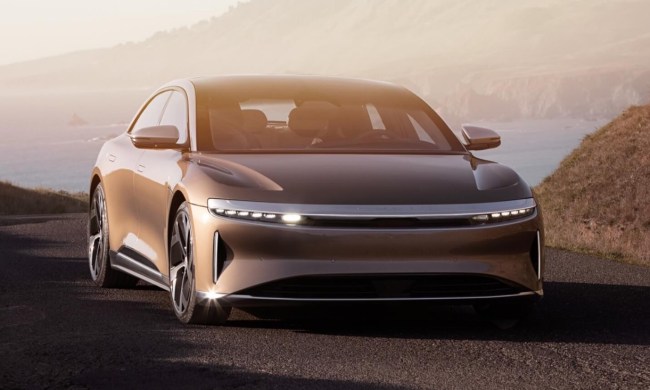Laugh and mock if you will, but the chance to visit one of America’s most notorious haunted sites doesn’t just rise up and claw its way out of the ground every day. So when we were offered the chance to pay the ghosts of Pennhurst Asylum a visit on their home turf, we summoned our courage and made a pact to hear the bells toll midnight in one of the most storied psychiatric hospitals of modern times.
Highway to Hell
To venture out in search of eldritch horrors, we selected the only appropriate vehicles in the world – a trio of 2018 Chevrolet Tahoe Midnight Edition SUVs. We also enlisted the help of the professionals at Ghost Hunts USA, who bring both paranormal sensitivity and bloodless scientific efficiency to the study of tortured spirits.
The full-size Tahoe offers you 94.7 cubic feet of cargo space, enough room to stack at least eight bodies and a shovel.
We climbed into the Tahoes in sleepy Phoenixville, Pennsylvania. On the surface, this is a quaint eastern community of several thousand souls, with neatly trimmed lawns fronting well-kept homes. But the town hides dark secrets in the nearby hills.
The Eastern Pennsylvania State Institution for the Feeble-Minded and Epileptic, better known as Pennhurst, was opened in 1908. We’ll spare you the details, but the institution was closed by judicial orders in 1987.
The Tahoe Midnight Edition stitches together an urbane blackout color scheme with Chevy’s rugged Z71 off-road package to build the perfect beast for the climb up Pennhurst hill. Even with the raised Z71 suspension and dual-range 4WD, the Midnight Edition cabin is quiet as the grave on the road.
Three rows of leather-trimmed seats provide ample space for you and six pallbearers. With the rear seats folded down, the full-size Tahoe offers you 94.7 cubic feet of cargo space, or in practical terms, enough room to stack at least eight bodies and a shovel.
The 5.3-liter Ecotec V8 engine provided us with 335 heart-pounding horsepower and 383 pound-feet of neck-snapping torque, and the six-speed automatic transmission was as smooth as the satin lining of a coffin. The base price of the 4WD Tahoe LT is $56,750 after all fees are applied, and the Z71 Midnight Edition package adds another $2,630. The Tahoes we had, however, were laden with all the nifty things, and carried a sticker price of $65,085.
Chasing Ghosts
Equipped with the latest in ghost-detection technology along with various totems and charms, we made our way out to Pennhurst like some sort of four-wheel-drive funeral procession. The Tahoe’s shift-on-the-fly 4WD got us up to the site, but to navigate the bogs and overgrown pathways, we dropped the transfer case into low range and powered through. Pulling onto the campus as light faded and night gathered around us, we took our first look at the skeletal remains of the asylum.
The chance to visit one of America’s most haunted sites doesn’t just rise up and claw its way out of the ground every day.
Pennhurst has mostly fallen into ruins now, overgrown with vines and trees as though the Earth itself seeks to reclaim the site and erase its scar upon the land. But a few buildings still stand in silent accusation, offering mute testimony of their history.
“You have to remember, the spirits we encounter were people once,” said one of our guides. “And they’re trapped here by what happened to them.”
Most buildings at Pennhurst are too decayed and dangerous to enter, but one bleak structure remains mostly intact. It is a foreboding four-story brick structure ironically called the Mayflower building. Once home to scores of patients, shadows now stare out of broken windows and speak with the creaking voice of rusty hinges and the howl of the chilly October wind. As you approach the door, abandoned gurneys and broken wheelchairs presage what you’ll find inside.
We began our hunt in the basement. All the buildings at Pennhurst were connected by a system of underground tunnels, and it was here our Medium began his attempts to communicate with the erstwhile residents. A special multi-spectrum scanner provided auditory enhancement to the responses from the beyond. The purgatory of the spirits is a large place, if the amount of echo in the scanner is any indication. But several words came through clearly: Trespasser, Leave, and of course, Demon.
In the course of our evening, we visited all four floors of the building, including the dormitory floors where patients lived. “The fourth floor is the most haunted,” our Medium told us. “But there’s a man on the ground floor who guards the entrance. He’s friendly, but he wants your shoelaces. You see, they weren’t allowed to have them when he was alive for fear of suicides.”
The phantoms were quiet that night, though our guides assured us that virtually every other time they’d been to Pennhurst, the poltergeists had been quite active. By midnight, we’d all heard enough creaks and bangs from the walls to last a (very abbreviated) lifetime, so we thanked the spirits for sparing us from ritual exsanguination, and made our way back to the Tahoes, spiriting away from crumbling Pennhurst and its ghastly remembrance. We locked the doors, switched on the heated seats, programmed the navigation to guide us to safety, and returned once more to the land of the living, praying only that nothing else had hitched a ride out with us.






